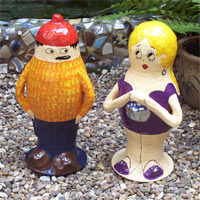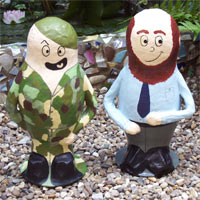Meet the Balloon People
Two balloon people are sealed with solvent outdoor varnishes and two with water based sealers.

- Solvent Sealers

- Water Based Sealers
Neville No-neck
(solvent sealer)
Neville No-neck is coated in yacht varnish. This seems to be a favourite choice of sealer for outdoor papier mache by people everywhere. Brushes must be cleaned in white spirit or brush cleaner. The tin I bought cost exactly the same price as the tin of exterior varnish I bought, so it will be interesting to see how they compare.
Manufacturer's comments:
"Tough and durable. External use. Resists all climatic conditions. Ideal for yachts and boats."
How I found it:
I'm not a lover of solvent products and avoid them where possible because of the fumes, but I found varnishing outside helped a great deal. The varnish went on very smoothly and it brought out the colours beautifully. It dried clear but darkened him a bit. I am expecting it to yellow in time.
Flora Floosie
(solvent sealer)
Flora Floosie is coated in "Exterior" varnish. It cost the same as the yacht varnish. Exterior varnish is made for wood and outside joinery. Brushes must be cleaned in white spirit or brush cleaner.
Manufacturer's comments:
"Exterior use. Absorbs ultraviolet light. Tough and durable. Protects against all weathers. Flexible."
How I found it:
It brushed on equally as smooth as the yacht varnish and brought out the colours. It seemed to be just a little clearer than the yacht varnish (with just a very slight tinge) so I preferred this one just going on looks alone.
Brian Bushybeard
(water-based sealer)
Brian Bushybeard is coated with white (pva) glue (Polyvinyl Acetate). I gave him 2/3 coats of diluted glue and a final coat undiluted. Brushes can be washed out in water. Please note that I bought a really good quality pva for this experiment which had added weatherproofing qualities. It was more costly than the normal pva I buy.
Manufacturerer's comments:
"High performance. Water resistant."
How I found it:
I use this glue a lot as a sealer for indoor papier mache, as well as an adhesive, as it dries clear. I am not too optimistic about its use as an outdoor sealer, but thought it was worth having a go. I wouldn't want to be without pva glue and I know a lot of other papier mache people feel the same way! Easy to use, as always. No fumes and dries very quickly. I found that this pva didn't dry 100 percent clear as my usual one. It had a very slight milky look to it, but this was only very miniscule and I was maybe being over picky.
Mad Major
(water-based sealer)
Mad Major is coated with a relatively new product called "Paverpol". Like pva, it is water based and the brushes can be washed out in water. Originating from Holland, it has just become available in other countries. This is my first ever experience with this product.
Manufacturer's comments:
"Paverpol can be used to make all sorts of materials rock-hard, such as textiles, paper, chamois leather, fibreglass, self-hardening clay and all kinds of natural materials. It will adhere to wood, ceramics, plaster, concrete, stone and tempex (polystyrene foam) etc.
Pavapol is watertight and resistant to the elements. An object placed in full sun may become flexible again, although when it cools it will regain its original shape. Once it has hardened, Paverpol is able to withstand extreme frost."
How I found it:
To look at, Paverpol resembles pva glue and is similar to apply (maybe just a bit thicker in consistency). It coated in much the same way. It also dried fast, but just like the better quality pva glue I used for Brian Bushybeard, it had a very feint milky film to it (only slightly more so). This dulled the colours ever so slightly. I think the best way to describe it is to say that it resembles placing a sheet of thick clear plastic over your finished work. This didn't detract from the piece and I think I only noticed it by standing it next to other pva coated items. This product is also harmless to animals and plants which is all good in my book. Pavapol is suposed to provide weatherproofing outdoors and so I am looking forward to seeing just what it can do.





